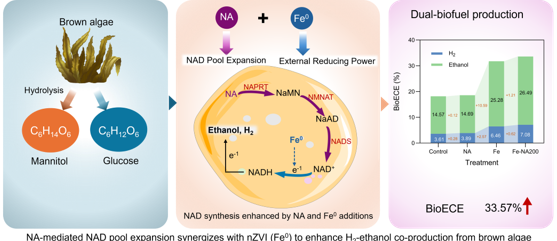Scientists Develop Coordinated Strategy to Boost Biofuel Production from Brown Algae
Biofuels derived from biomass like brown algae represent a sustainable solution to the global energy crisis and environmental challenges. Brown algae are considered an ideal third-generation feedstock because they do not compete with food crops and grow rapidly. However, the efficiency of converting this biomass into valuable biofuels has been limited by metabolic bottlenecks within the fermenting microorganisms, a key problem hindering the economic viability of marine biorefineries.
To overcome this bottleneck, Prof. LI Weiming from the Institute of Applied Ecology, Chinese Academy of Sciences, has developed an innovative solution. Their findings were published in the International Journal of Hydrogen Energy on July 22, under the title "Unlocking synergistic hydrogen-ethanol co-production from brown algae through nicotinic acid-mediated NAD pool expansion." In the paper, the researchers introduce a "coordinated engineering" strategy, which centers on the simultaneous application of nicotinic acid (NA) and nano zero-valent iron (nZVI) to achieve a powerful synergistic effect.
The researchers hypothesized that maximizing biofuel production requires addressing two separate limitations at once: the limited supply of electrons and the limited pool of intracellular electron carriers (NAD+/NADH). Their strategy uses nZVI as an external electron donor to provide extra reducing power, while NA, a precursor for NAD synthesis, is used to expand the total pool of electron carriers within the bacterium Ethanoligenens harbinense.
The results demonstrated a clear synergy between the two supplements. When used together under optimal conditions, the strategy increased the total hydrogen yield by 84.05% and the ethanol yield by 81.98% compared to the control group. This boosted the total Bioenergy Conversion Efficiency (BioECE) to 33.57%, an 84.65% improvement.
"Our work reveals a critical principle: the true innovation lies in the synergy. NA provides more carriers, and nZVI provides the extra electrons," said LI Weiming. "This coordinated approach, tailored to the substrate's properties, represents a more sophisticated and adaptable strategy for biofuel production."
Mechanistic analysis confirmed that the coordinated strategy upregulated key genes in the NAD synthesis pathway and created a more reducing intracellular environment, which in turn enhanced the activity of key enzymes responsible for hydrogen and ethanol synthesis.
This study highlights the significant potential of combining metabolic cofactor engineering with reducing power supplementation. Future efforts will focus on process optimization to realize the full potential of this strategy within the marine biorefinery concept.
This research was supported by the National Natural Science Foundation of China, CAS Pioneer Hundred Talents Program, Natural Science Foundation for Excellent Young Scholars of Liaoning Province, Science and Technology Agency Livelihood Program of Liaoning Province of China.

Figure 1. The graphic abstract illustrates how nicotinic acid (NA) expands the electron carrier pool while nano zero-valent iron (nZVI) provides external electrons, synergistically enhancing hydrogen and ethanol production from brown algae. (Image by LI Weiming et al.)



